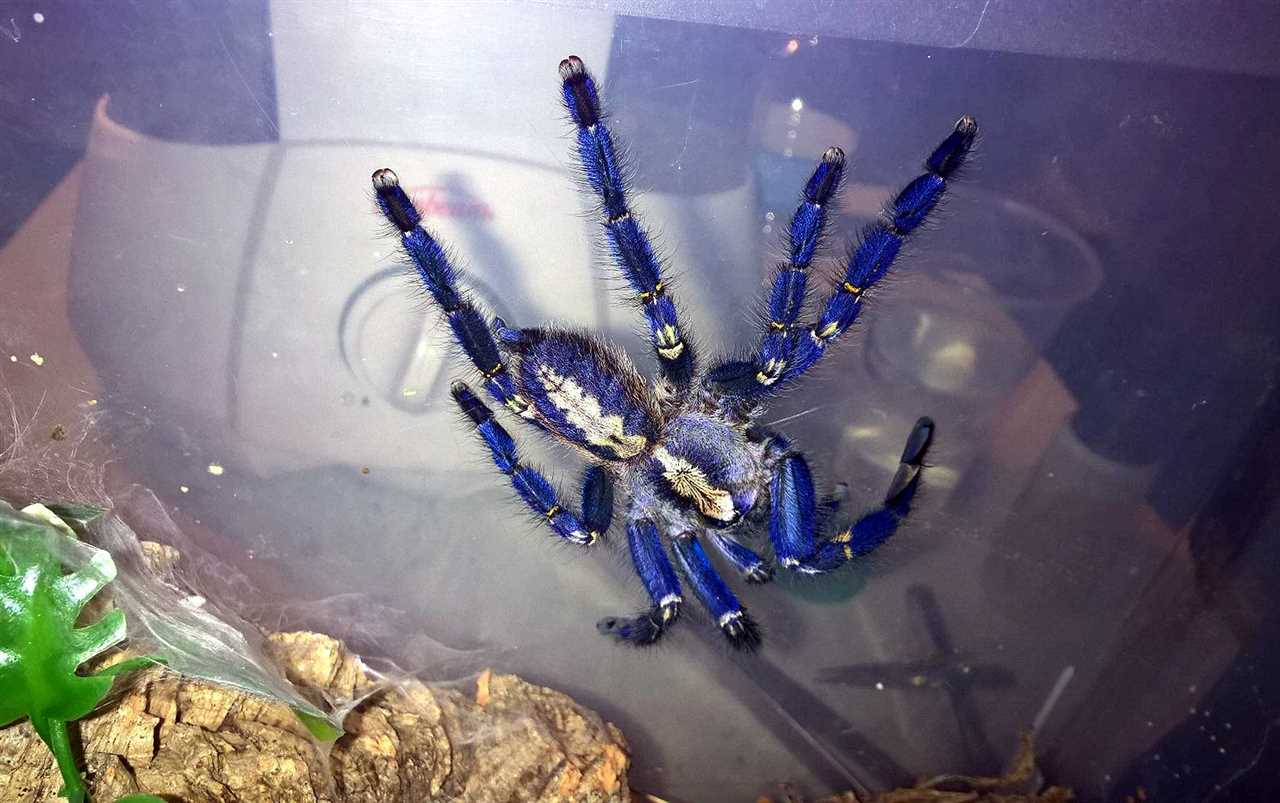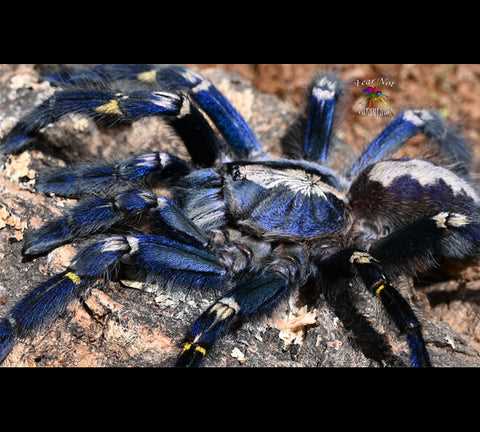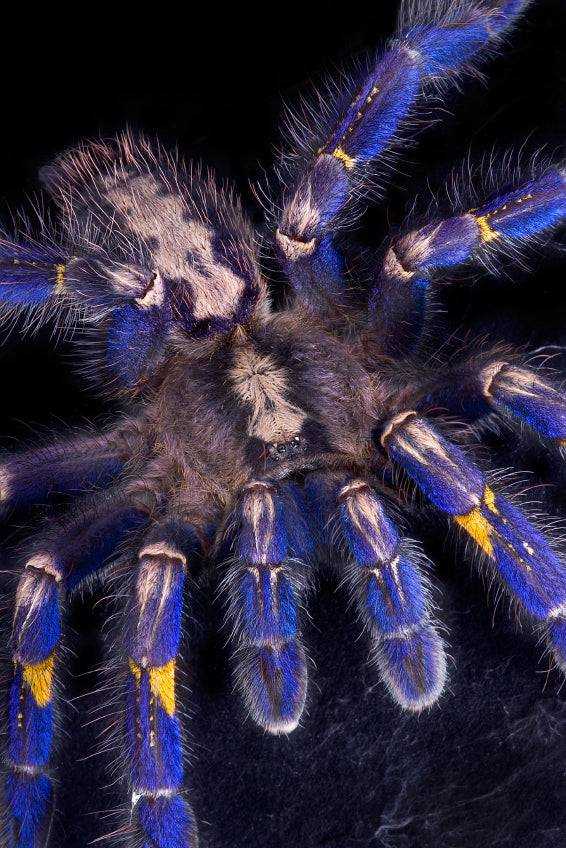Creating the perfect enclosure for your Gooty Sapphire Tarantula is crucial. It needs a spacious and secure habitat with plenty of room for the spider to move around and create its web. A terrarium with a vertical setup is ideal, as it mimics their natural environment. It is recommended to include branches, plants, and other vertical elements for the tarantula to climb on.
Choosing the right substrate is essential for the Gooty Sapphire Tarantula’s well-being. A combination of coconut fiber and peat moss works well to maintain moisture and provide a soft surface for the spider to burrow. The depth of the substrate should be enough to allow for burrowing, typically around 3-4 inches, depending on the size of the spider. Keeping the substrate moist, but not wet, is important to maintain the necessary humidity levels.
Feeding the Gooty Sapphire Tarantula involves offering a diet of live insects such as crickets, roaches, or locusts. These should be appropriately sized for the spider, as oversized prey may harm the tarantula. It is crucial to ensure that the feeders are gut-loaded and dusted with calcium supplements to provide optimal nutrition for your tarantula. Feedings should occur about once a week, but the frequency may vary depending on the spider’s age and size.
Maintaining the proper humidity levels is crucial for the Gooty Sapphire Tarantula’s overall health. These spiders require a humidity level of around 70-80%. This can be achieved by misting the enclosure with dechlorinated water regularly. A hygrometer can be used to monitor the humidity levels, ensuring that they remain within the appropriate range. Improper humidity levels can lead to health issues such as dehydration or difficulty molting.
The Gooty Sapphire Tarantula is not only a fascinating pet but also a highly sought-after species in the pet trade. If you decide to breed and sell these spiders, it is vital to educate yourself about their specific breeding requirements. Breeding can be complex and requires careful attention to temperature, humidity, and appropriate pairing. Properly acclimating and transporting the spiders is also crucial to ensure their safe arrival to their new homes.
Keeping and selling Gooty Sapphire Tarantulas can be a rewarding endeavor for arachnid enthusiasts. With proper care, these beautiful spiders can thrive and become the center of attention in any collection. By following these care tips and ensuring a suitable environment, you can provide the best possible care for your Gooty Sapphire Tarantula and potentially share their beauty with other passionate arachnid lovers.
Appearance
The Gooty Sapphire Tarantula is truly a sight to behold. Its metallic blue color shines brilliantly, making it one of the most visually striking tarantulas in the world. The spider’s body is covered in iridescent blue hairs, giving it a shimmering effect. The legs of the Gooty Sapphire Tarantula are a deep blue-black color, making the contrast between the body and legs even more striking.
Habitat
Behavior
Care
Proper care for the Gooty Sapphire Tarantula is essential in order to ensure its health and well-being. This includes providing a suitable enclosure, maintaining the correct temperature and humidity levels, and offering a proper diet.
Enclosure
The enclosure for the Gooty Sapphire Tarantula should be spacious enough to allow it to move around comfortably. A glass terrarium or plastic container with ventilation holes can be used. The enclosure should be escape-proof and provide enough space for the tarantula to create burrows or climb on branches or other decorations.
Temperature and Humidity
The Gooty Sapphire Tarantula requires a temperature range of 75 to 85 degrees Fahrenheit (24 to 29 degrees Celsius). The humidity level should be kept at around 70 to 80 percent, which can be achieved by misting the enclosure with water regularly and providing a water dish for the tarantula to drink from.
Feeding
Substrate

The substrate in the Gooty Sapphire Tarantula’s enclosure should mimic its natural habitat. A mixture of peat moss, coconut fiber, and vermiculite can be used as a substrate. The depth of the substrate should allow the tarantula to create burrows for hiding and molting.
Overall, the Gooty Sapphire Tarantula is a fascinating and beautiful species to keep as a pet. By providing it with the proper care and environment, you can enjoy the unique beauty and behavior of this incredible spider. Remember, always do your research and consult with experts to ensure the best care for your tarantula.
Feeding the Gooty Sapphire Tarantula is relatively straightforward. Like other tarantulas, it is a carnivorous spider that preys on insects and other small arthropods. It is recommended to feed them a diet of live crickets, roaches, and other appropriate-sized prey items. Make sure to provide clean water at all times as well.
Feeding and Nutrition

Feeding and nutrition are crucial aspects of caring for your Gooty Sapphire Tarantula. As an obligate carnivore, this stunning spider requires a diet primarily consisting of live insects. The main sources of nutrition for your Gooty Sapphire Tarantula should be appropriately sized prey items such as crickets, roaches, and other small invertebrates.
When feeding your Gooty Sapphire Tarantula, it is essential to make sure the prey is properly sized. Food items should be no wider than the spider’s body, as larger prey can overwhelm or injure your tarantula. In addition, make sure to remove any uneaten prey after 24 hours to prevent it from harming your spider or the enclosure’s cleanliness.
It is crucial to monitor your tarantula’s feeding habits and adjust the frequency and size of prey accordingly. Overfeeding can lead to obesity and health issues, while underfeeding can result in malnutrition and stunted growth.
Overall, ensuring a balanced and appropriate diet is essential for the well-being and longevity of your Gooty Sapphire Tarantula. By offering a variety of appropriately sized prey items and monitoring your tarantula’s feeding behavior, you can help maintain its health and vibrant sapphire coloration.
Temperature and Humidity Requirements
Proper temperature and humidity levels are crucial for the care of the Gooty Sapphire Tarantula. These beautiful spiders are native to the tropical forests of India and require specific conditions to thrive in captivity.
Ideal Humidity Levels
The Gooty Sapphire Tarantula is highly dependent on humidity, as it mimics its natural rainforest habitat. Aim to maintain a humidity level of 70-80% in the tarantula’s enclosure. You can achieve this by misting the enclosure with water regularly.
Temperature Range
The Gooty Sapphire Tarantula thrives in temperatures ranging from 75-85°F (24-29°C). Avoid extreme temperature fluctuations, as it can stress or even harm the spider. Use a reptile heat mat or a heat lamp to maintain a consistent temperature within the enclosure.
Additionally, it is essential to place the tarantula’s enclosure away from direct sunlight or any sources of heat or cold drafts. Exposure to direct sunlight can cause overheating, while drafts can lower the temperature and disrupt the tarantula’s natural environment.
Monitoring and Adjusting
To ensure the proper temperature and humidity levels, use a digital thermometer and hygrometer to monitor the conditions inside the enclosure. Regularly check these devices to ensure they are accurate and make adjustments if necessary.
The key to maintaining a healthy and happy Gooty Sapphire Tarantula lies in providing the right temperature and humidity levels in its enclosure. By closely monitoring and adjusting these factors, you can create an environment that mimics its natural habitat and ensure the well-being of your tarantula.
Setting Up Your Gooty Sapphire Tarantula’s Enclosure
1. Carefully Choose the Tarantula Enclosure
Selecting the right enclosure is the first step in setting up a suitable habitat for your Gooty Sapphire Tarantula. Make sure to choose a tank or terrarium that provides enough space for your tarantula to move around comfortably. A secure lid is also essential to prevent any escape attempts.
2. Optimal Substrate for Your Tarantula
The substrate you choose for your tarantula’s enclosure is important for maintaining proper humidity levels and promoting healthy burrowing behavior. A substrate mixture of coconut fiber, peat moss, and topsoil works well for Gooty Sapphire Tarantulas. This mixture retains moisture while allowing for proper drainage.
3. Create Hiding Spots and Decorations
Gooty Sapphire Tarantulas are natural burrowers, so it’s crucial to provide them with plenty of hiding spots and decorations in their enclosure. You can use cork bark, hollow logs, or specially designed hides to create safe and secure hiding places for your tarantula. Additionally, adding some decorations like fake plants or branches can help create a more natural and visually appealing habitat.
4. Maintain Proper Temperature and Humidity
5. Lighting and Ventilation
Gooty Sapphire Tarantulas do not require UV lighting, but they do need a consistent light and dark cycle. Use a low-wattage bulb to simulate daylight hours and provide a natural day-night rhythm. Remember to also provide adequate ventilation to prevent stagnant air and promote healthy air circulation.
6. Furnish the Enclosure with Water and Feeding Dish
Make sure to provide a shallow water dish that your tarantula can access easily without the risk of drowning. It’s essential to keep the water dish clean and filled with fresh, dechlorinated water at all times. Additionally, place a small feeding dish in the enclosure to feed your tarantula. This will prevent any mess and make it easier to clean up leftovers.
By following these guidelines and paying attention to the specific needs of your Gooty Sapphire Tarantula, you can ensure that your pet has a comfortable and secure living environment. Remember to regularly monitor the conditions and make adjustments as needed to provide the best care possible for your tarantula.
Tank Size, Substrate, and Decor
Heating and Lighting
Gooty Sapphire Tarantulas prefer temperatures between 75°F and 85°F (24°C to 29°C), with a humidity level of around 70% to 80%. To achieve these conditions, you can use a heat mat or heat lamp to provide gentle heat. It’s essential to monitor the temperature and humidity levels regularly to ensure they remain within the recommended range.
Feeding and Watering
Following these care guidelines will help ensure that your Gooty Sapphire Tarantula thrives in its enclosure. Remember to perform regular maintenance by cleaning the tank, removing any uneaten prey, and monitoring temperature and humidity levels. With proper care and attention, your Gooty Sapphire Tarantula will lead a healthy and fulfilling life as your unique pet.
Lighting and Ventilation
Proper lighting and ventilation are essential for the care of Gooty Sapphire Tarantulas. These spiders require a light-dark cycle to mimic their natural habitat and promote regular feeding and molting patterns.
Overall, providing appropriate lighting and ventilation is crucial for the well-being of your Gooty Sapphire Tarantula. By ensuring a suitable light-dark cycle, moderate lighting, and proper air circulation, you can create a comfortable and healthy environment for your spider to thrive in.
Caring for Your Gooty Sapphire Tarantula
Proper care and attention are essential for maintaining the health and well-being of your Gooty Sapphire Tarantula. Follow these guidelines to ensure your spider thrives in its environment:
Housing
Provide a spacious and secure enclosure for your Gooty Sapphire Tarantula. A terrarium or glass tank with a secure lid is recommended to prevent any escapes. Choose an appropriate tank size based on the spider’s size and provide enough substrate for burrowing.
Humidity
Gooty Sapphire Tarantulas require a moderately high humidity level to thrive. Maintain the humidity level between 70% and 80% by misting the enclosure with water regularly. You can also use a hygrometer to monitor the humidity level accurately.
Temperature

Feeding
Gooty Sapphire Tarantulas are carnivorous and primarily feed on insects. Offer a variety of appropriately sized live prey, such as crickets, roaches, and mealworms. Make sure to research and understand the specific prey requirements for your tarantula’s size and age.
Substrate
Environmental Enrichment
Add various hides, branches, and artificial plants to the enclosure to create a stimulating and natural environment for your tarantula. This will provide opportunities for climbing, hiding, and webbing, mimicking their natural habitat.
Remember to clean the enclosure regularly to maintain good hygiene and remove any uneaten prey. Observe your Gooty Sapphire Tarantula regularly to ensure it is behaviorally and physically healthy. Any significant changes in behavior or appetite should be evaluated promptly, and adjustments to care should be made accordingly.
Handling and Socialization
While some tarantula owners may attempt to handle their spiders, it is generally recommended to avoid handling the Gooty Sapphire Tarantula unless necessary for maintenance purposes, such as cleaning their enclosure or moving them to a new tank.
If handling is required, it’s essential to take precautions to ensure both your safety and the well-being of the spider. The first step is to make sure your hands are clean and free from any perfumes, lotions, or other substances that could be harmful to the spider.
To safely handle your Gooty Sapphire Tarantula, use a soft paintbrush or similar tool to gently coax the spider onto your hand or another surface. Never force the spider to come into contact with your hand or fingers, as this can cause stress and potentially harm the spider.
It’s also important to note that tarantulas, including the Gooty Sapphire Tarantula, do not require socialization like other pets. They are solitary creatures and do not benefit from interactions with humans or other tarantulas. In fact, excessive handling or socialization can cause stress and lead to health issues.
Remember to always prioritize the well-being and safety of your Gooty Sapphire Tarantula. If you have any concerns or questions about handling or socialization, it’s recommended to consult with a knowledgeable exotic pet veterinarian or experienced tarantula keeper.

I’m Lena Adams—a product of an unconventional upbringing in the African wilderness. My father, a daring explorer of African wildlife, sparked my fascination with reptiles, a passion that intertwined with the tragic loss of my mother during an expedition, leaving an indelible mark on my life. Driven to understand the creatures that captivated my parents, I embarked on my journey, sharing insights about reptiles, frogs, and lizards on my website. Through my explorations and conservation efforts, I honour my family’s legacy while seeking connections—to the creatures, nature, and the mother whose presence I yearn to understand.
